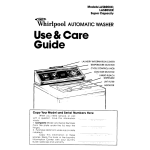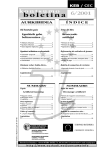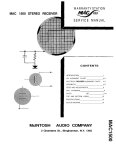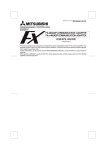Download MOTM-820 User Manual
Transcript
MOTM-820 Voltage-Controlled Lag Processor Assembly Instructions & Owner’s Manual Synthesis Technology 6625 Quail Ridge Dr. Fort Worth, TX 76180 (817) 498-3782 www.synthtech.com Dec. 4, 2000 MOTM-820 PARTS LIST Please carefully check that all parts are in your kit. If you have a suspected shortage, please call or email. If you get free extra stuff, keep it for next time. Capacitor bag, containing the following 12 parts: 2ea 10mfd, 50V Electrolytic C10, C11 1ea 22pf (marked 220) ceramic axial C4 1ea 0.1mfd (marked 100N or 104) yellow box C7 2ea 1000pf yellow box (marked 1N or 102) C1, C12 6ea 0.1mfd (marked 104) ceramic axial C2, C3, C5, C6, C8, C9 Resistor bag, containing the following 32 parts: 6ea 10K (brown, black, orange) 4ea 15K (brown, green, orange) 4ea 51K (green, brown, orange) 3ea 2K7 (red, violet, red) 3ea 200K (red, black, yellow) 2ea 1K (brown, black, red) 2ea 120K (brown, red, yellow) 2ea 100K 0.1% RN55E (marked 1003B) 1ea 470 ohm (yellow, violet, brown) R1 1ea 100 ohm (brown, black, brown) 1ea 7K5 (violet, green, red) 1ea 475K 1% (yellow, violet, green, orange) 1ea 1.0M 1% (brown, black, black, yellow) 1ea 1K8 5% (brown, gray, red) R3, R13, R14, R15, R27, R28 R17, R19, R20, R23 R2, R6, R26, R32 R5, R29, R30 R7, R8, R9 R16, R21 R18, R22 R24, R25 R4 R10 R11 R12 R31 IC bag, containing the following 10 parts: 3ea BC550C NPN transistor 2ea BC560C PNP transistor 1ea 1N4148 diodes 2ea MXL1013 dual op amp 1ea TL084 quad op amp 1ea DG213DJ CMOS quad switch Q1, Q3, Q4 Q2, Q5 D1 U1, U2 U3 U4 Misc #1 bag, containing the following 6 parts: 2ea Axial ferrite beads (plain, gray things)L1, L2 1ea MTA-156 power connector JP1 1ea SPDT (ON-ON) toggle switch SW1 1ea 5K Bourns trimpot 25-turn TP1 1ea red LED, panel mount D2 SYNTHESIS TECHNOLOGY MOTM-820 ASSEMBLY 12/4/00 WWW.SYNTHTECH.COM PAGE 2 Knobs, 4ea, ALCO PKES90B1/4 Jacks, 8ea Switchcraft 112A Pots, 4ea containing the following: 4ea 100K cermet Spectrol 149 VR1 – VR4 Front panel Mounting bracket Wire bag, containing the following 11 wires: 3ea RG-174 coax, 4 ½ inches 1ea RG-174 coax, 7 inches 1ea 2-wire set, 22ga. 6 inches (orange/white) 5ea 2-wire set, 22ga. 3 inches (red/black) 1ea Power Cable, 20” Hardware bag, containing: 4ea #8-32 x 3/8 black screws (for mounting module to rack) 4ea #6-32 x 1/2 zinc screws (for attaching pc board to bracket) 4ea 1/4 inch aluminum spacers 6ea #6 KEPS nuts (2 for attaching bracket to front panel, 4 for pc board) 2ea small heat-shrink tubing 5ea small tie-wraps Organic Solder No-clean Solder PC Board, MOTM-820 SYNTHESIS TECHNOLOGY MOTM-820 ASSEMBLY 12/4/00 WWW.SYNTHTECH.COM PAGE 3 GENERAL INFORMATION Thank you for purchasing the MOTM-820 Voltage-Controlled Lag Processor. If you have any issues concerning the building or use of the kit, please contact us at (888) 818-MOTM [6686] or by email: [email protected]. This kit should take the average builder between 3 to 4 hours. The kit contains many different resistors and special parts. However, please remember this is NOT a speed contest; it is an accuracy contest. There is no rule that you have to complete the entire kit in one day (as long as you wash the flux off!). Successful kit building relies on having the proper tools. Here is a list of what you will need to build your MOTM-820: • • • • • • • • • • • Soldering iron, 50W max power Needle-nose or chain-nose pliers Diagonal cutters Allen key set for securing the knobs (1/16” or 1.6mm) Magnifying glass: to read the capacitor codes and to inspect solder joints Lead bending tool (optional, but makes the job go much faster) DVM (Digital Volt Meter) or oscilloscope (to check the output) #1 Philips screwdriver Fingernail brush for washing off the organic flux Old towel for blotting dry pc board Heat-shrink gun is highly recommended! For more information of tools used and suggestions, see the MOTM FAQ and Tutorial pages at http://www.synthtech.com. HOW TO FOLLOW THE DIRECTIONS Please read the entire instruction before proceeding. There may be valuable information at next to it. After you the end of the instruction. Each instruction has a check box complete the instruction, check the box. This way you can keep track of where you are in the process. VERIFY THE PARTS LIST Verify that all of the parts are in the kit as shown on the parts list. SYNTHESIS TECHNOLOGY MOTM-820 ASSEMBLY 12/4/00 WWW.SYNTHTECH.COM PAGE 4 A WORD ON SOLDERING There are 2 very different types of solder used in the kit. Most of the soldering uses ‘Organic Flux’ solder. This is strictly for use on the pc board, and is NOT to be used on the front panel wiring! In order for solder to ‘stick’ to the copper, a chemical called ‘flux’ is embedded in the solder. The flux leaves a residue on the pc board that should be cleaned with warm water. DO NOT USE SOAP OR OTHER CLEANSERS. Most of the parts in the kits are ‘waterproof’ and can be washed in the sink. The flux is OSHA approved for flushing down the drain, so don’t worry about that! A soft brush is used to gently scrub the board. We recommend a ‘fingernail brush’, which is about 1” x 2” and can be found for about $1. The other type of solder is called ‘No Clean Flux’; because as the name implies it does not require washing. This solder is used for wiring the pots, switches, jacks, etc. This solder is harder to use on the pc board; because even when melted, it is not very fluid (about the consistency of toothpaste). We will use it VERY SPARINGLY on the pc board. OK, let’s get started on the board! PART #1: SOLDERING THE RESISTORS Since there are more resistors than anything else, we will start here. If you do not know the resistor color code, refer to the parts list. Resistors are not polarity sensitive, but the board will be easier to debug (and look nicer) if you point the first color band in the same direction for all the parts. The color code is also in the README FIRST document that every customer receives with his or her first order. You will start by soldering in ALL of the resistors. Find the RESISTOR bag. Find the MOTM-820 blank pc board. There is a copy (larger than actual size) of the silkscreen which shows where the parts go at the end of this document. It will be useful if you locate the part on the print first, put the part in the board, then ‘check off’ the silkscreen. All parts are inserted from the side of the board with the white silkscreen (the “top” side). NOTE: some reference designators are under the resistor! Be careful. We will stuff the resistors by value to make things easier. The resistors (and other long-leaded parts) are inserted on a 0.4 inch spacing. The important thing is to be sure that the part is sitting all the way down on the board. Push the leads in the holes, push the part on the board, and then bend the leads on the bottom outwards to a 45 degree angle (roughly!). This is called ‘cinching the leads’: and keeps the part from falling out! From the bottom of the board, solder (using the organic flux), applying heat to the pad for about a half second first, then applying just enough solder to make a small puddle that looks like a tiny pyramid. Enough solder should SYNTHESIS TECHNOLOGY MOTM-820 ASSEMBLY 12/4/00 WWW.SYNTHTECH.COM PAGE 5 flow in the hole such that on the top (component) side, a small amount is on the top pad as well The rule of soldering: don’t use too much, you can always add more! Cut the leads flush with the top of the solder joint with your diagonal cutters. NOTE: later in the assembly, you will need a scrap of resistor lead. Be sure to save a piece. Locate the 10K resistors (6pcs). Solder the resistors into R13 and R15 (left of VR2), R14 (left of U3), R27 (bottom right corner), R3 (by D1) and R28 (above U2). Locate the 15K resistors (4) and solder into R17 (above R23), R19 (left of VR2), R20 (above VR3), and R23 (left of U3). Locate the 51K resistors (4) and solder into R2 (below Q3), R6 (by L2), R26 (left of VR3) and R32 (below Q3). Locate the 2K7 resistors (3) and solder R5 (top edge), R29 (beside J4) and R30 (by VR4). Locate the 200K resistors (3) and solder into R7 (by VR2), R8 (by VR1) and R9 (by VR3). Locate the 470 ohm resistor and solder into R1 (right of U1). Locate the 1K resistors (2) and solder into R16 (below SW1) and R21 (by C8). Locate the 120K resistors (2) and solder into R18 (by VR2) and R22 (by C8). Locate the 100K 0.1% resistors (2) and solder into R24 and R25 (left of VR3). Locate the 7K5 resistor and solder into R10 (left of U1). Locate the 475K 1% resistor and solder into R11 (above R10). Locate the 1.0M 1% resistor and solder into R12 (turned sideways, by U2). Locate the 1K8 resistor and solder into R31 (by J4). Locate the 100 ohm resistor and solder into R4 (last one left!). PART #2: BOARD WASH #1 Verify all the resistors are in the correct position. SYNTHESIS TECHNOLOGY MOTM-820 ASSEMBLY 12/4/00 WWW.SYNTHTECH.COM PAGE 6 Verify all the resistors are flat on the board. Correct if needed. Check solder joints. Wash the board in warm water, gently scrubbing both sides. DO NOT USE ANY SOAP! Just water! Shake the board a couple of times, blot dry with an old towel (the leads will frazzle a good towel). Let dry at least 15 minutes. Take a little break! You are about 1/3rd of the way finished. PART #3: CAPACITORS Locate the CAPACITOR bag. Locate the 0.1mfd yellow box cap and solder into C7 (lower left of U3). Locate the 0.001mfd yellow box caps (2) and solder into C1 (above J2) and C12 (by J8). Locate the 22pf ceramic axial cap and solder into C4 (left of U1). Locate the 0.1mfd axial ceramic caps (6) and solder into C2, C3, C5, C6, C8 and C9. Locate the 10µfd electrolytics (2). Note that there is a stripe on the NEGATIVE terminal. The pc board has a + on the POSITIVE terminal. Carefully stick the capacitors into C10 and C11 with the stripe away from the + pad on the board. PART #4: MISC and IC STUFF Almost done with the parts on the pc board! This will finish up the soldering with the organic flux. Save the trim pot for later. Locate the MISC #1 bag and the IC bag. Locate the ferrite beads (2). They are axial parts, gray colored with no markings. These are non-polar, and are soldered into L1 and L2 (by JP1). Locate the MTA-156 power connector. Solder into JP1. Note that the connector has a ‘locking tab’ on one side. This side is the “inside” facing relative to the pc board. Note the silkscreen symbol for JP1 has a line on one side, indicating this is the side where the locking tab goes. SYNTHESIS TECHNOLOGY MOTM-820 ASSEMBLY 12/4/00 WWW.SYNTHTECH.COM PAGE 7 Locate the MXL1013 op amps (2). Solder into U1 and U2. Note that all ICs are pointing “down” towards the bottom edge of the pc board. The IC will have a ‘notch’ or indentation in the top by Pin #1. Locate the 1N4148 diode. Notice it has a black band near one end. This is the cathode, and there is a matching band on the silkscreen for D1. Solder the diode, with the banded end pointing to the left. Locate the TL084 op amp. Solder into U3. Locate the DG213DJ. Solder into U4. Locate the BC550C transistors (3) Match the flat side of the part to the flat side shown on the silkscreen. Place the transistor in the holes, but do NOT press the transistor all the way to the pc board. Leave about 0.1 inch of the leads exposed between the pc board and the underside of the transistor. Solder into Q1, Q3 and Q4.. Locate the BC560C transistors (2). Solder into Q2 and Q5. Apply a small bit of solder to the via holes. These are the small pads that allow traces to “change sides” of the pc board. DO NOT SOLDER PADS FOR THE REMAINING COMPONENTS!! As an example, if you look at J1, you will see 4 via holes around it. PART #5: FINAL BOARD WASH & INSPECTION Verify all the parts are in the correct locations. Make sure all of the ICs are pointing the same direction. Make sure all of the transistors are facing the same direction. Inspect the solder joints. Any solder shorts? Too much solder? Missing joints? Wash the board under warm water. Scrub gently. Dry. THIS IS A GOOD STOPPING PLACE TO REST OR PUT THE KIT AWAY UNTIL LATER. Don’t lose the trim pot, it goes on with no-clean solder in the next section. You are now finished with the Organic flux solder. All soldering past this point is using the No-Clean solder. You do not have to wash the board anymore. PART #6: FINISHING THE PCB You will now solder in the remaining parts on the pcb in preparation for wiring to the front panel. USE THE NO-CLEAN SOLDER. BE CAREFUL! SYNTHESIS TECHNOLOGY MOTM-820 ASSEMBLY 12/4/00 WWW.SYNTHTECH.COM PAGE 8 Locate the Bourns 5K blue trim pot. Solder it into TP1. Be sure it is flat on the pc board. Locate the Spectrol pots. They mount into VR1-VR4. Be sure they are flat and sticking out perpendicular to the pc board. Locate the 4 pieces of RG-174 black coax cable. Again, note that one end has longer wires stripped than the other. The short ends will go in the pc board in locations J5 – J8. Look at the pc board. Notice that in the coax positions, there is a large hole pad (lower pad) and a smaller pad (top hole). The braided wire is soldered into the larger hole. The smaller, inner conductor goes in the top hole. BE SURE THE SHORTER BRAIDED END GOES INTO THE PC BOARD. The 1 LONG coax cable solders into J5. The 3 SHORT coax cables go into the other locations. Solder each coax cable into the holes. Attach a tie-wrap to secure the coax cable flush to the board. The tie-wrap goes down, into the left hole and up through the right hole. Secure and trim off any excess. Find the 5 red/black twisted wires. They go into D2, SW1, J2, J3 and J4. Solder the Red wire into pad #1 and the Black wire into pad #2. Note that for D2 and SW1, the red & black wires are “inverted” with respect to the others. Find the orange/white twisted wires. It solders into J1. The White wire goes in pad #1 and the Orange wire into pad #2. YOU ARE NOW FINISHED WITH THE PC BOARD WORK! BREAK TIME. PART #7: FRONT PANEL PREPARATION You will now attach components to the front panel. It is HIGHLY recommended that you use a set of hollow shaft nut drivers, NOT PLIERS, to tighten the nuts. This prevents scratching. NOTE: all references to part orientation is from the REAR of the panel. Locate the 8 Switchcraft jacks. Notice that from the rear, there is a beveled corner. This corner is ALWAYS CONNECTED TO GROUND, USUALLY WITH A BRAIDED CONDUCTOR. Each jack has a flat washer, a lockwasher, and a ½” hex nut. Remove the nuts and washers from each jack. Place aside. Keep the lockwasher on the jacks. Insert the 8 jacks/lockwashers, with the beveled corner in the upper right corner, into the 8 holes. Place the flat washer on the jack, then the hex nut. Hold the jack with one hand on the backside, keeping it ‘square’. Tighten the hex nut with a nut driver. NOTE: when tight, not much of the exposed threads of the jack are exposed. Remember that resistor lead scrap you have been saving? It solders on the IN jack. SYNTHESIS TECHNOLOGY MOTM-820 ASSEMBLY 12/4/00 WWW.SYNTHTECH.COM PAGE 9 Solder the scrap in between the TOP and the BEVELED lugs. You are now ready to attach the pc board to the bracket and then wire up to the panel. PART #8: ATTACH PC BOARD TO BRACKET/PANEL In the HARDWARE bag, locate 4 #6-32 x 1/2 screws, 6 #6 KEPS nuts, and 4 spacers. Locate the mounting bracket. The pc board attaches to the bracket, with the 4 screws threading from the top of the board, through the spacers, through the bracket, and then out the bottom of the bracket. The #6 KEPS nut attaches on the bottom of the bracket. Note the bracket has 2 long mounting flanges with a hole in each. These attach to the 2 threaded studs sticking out of the rear of the panel. The 4 pots each stick in its panel hole when the bracket is screwed down on the 2 threaded posts. Attach the pc board to the bracket. The flanges will point upwards when the pc board is sitting on the bracket. Note that the bracket holes for the pc board are actually oblong. This is to allow adjustment for the pc board to firmly press up against the back of the panel. As a start, set the 4 screws ALL THE WAY TO THE LEFT of the oblong holes. Loosely tighten the 4 KEPS nuts on the bottom. THIS IS A VERY IMPORTANT STEP, SO PAY ATTENTION AND READ ALL OF IT BEFORE PROCEEDING! Note that each of the 4 pots on the pc board have 2 hex nuts and a flat washer. Remove the first hex nut and the washer. Set aside. What you will do now is adjust the remaining hex nuts so that when the bracket is all the way down on the panel’s threaded studs, all the pot hex nuts touch the rear of the panel. Screw (by hand) each hex nut on the pots so that it is all the way on (touching the face of the pot). Now, pick up the pc board/bracket assembly and carefully slide it over the 2 threaded studs, making sure the pots are aligned in the holes. Use 2 #6 KEPS nuts and tighten the bracket to the panel. Loosen the 4 KEPS nuts on the bottom of the bracket. Slide the pcb ALL THE WAY TO THE RIGHT AS FAR AS IT WILL GO, so that the 4 pot nuts are all pressing against the panel. By hand, put hex nuts on the outside threads of VR1 and VR4 to keep the pc board in place. Now, tighten the 4 KEPS nuts on the bracket. The pcb and bracket should be secure, with no gaps visible between the panel and the pot nuts. You may need to loosen the nuts on the pots, so that they are touching the back of the panel. Again, make sure each pot’s nut is touching the back of the panel (no gaps!). There will be a gap from the edge of the pc board to the panel. SYNTHESIS TECHNOLOGY MOTM-820 ASSEMBLY 12/4/00 WWW.SYNTHTECH.COM PAGE 10 Remove the hex nuts on VR1 & VR4. For all of the pots, first put on the flat washer, then the hex nut. Tighten with a ½” nut driver. PART #9: FINISH WIRING TO THE PANEL Please read the following instructions carefully. In order to neatly attach the many wires to the front panel components, the wires are soldered in a specific order. Find the SPDT toggle switch. Insert the switch into the panel hole labeled BYPASS. Tighten the outside hex nut, but DO NOT OVERTIGHTEN!! Be sure the switch is oriented so the lever operates “up and down” and not “side-to-side”! The lockwasher goes on the inside of the panel. Now you will solder to the BYPASS mode switch. The SW1 Black wire goes to the CENTER lug. The Red wires goes to the BOTTOM lug. The TOP lug is not used. Find the red LED assembly. Note that one lead is slightly longer. This is the Anode, and it is soldered to the Red wire in D2. The other lead is the Cathode, and is soldered to the Black wire. Insert the LED through the panel, with the longer Anode lead towards the top panel edge (looking from the rear, this is towards the “left”). Press the LED snugly to the panel. Now, cut off half of the LED’s leads (they are too long!). With a pair of chain-nosed pliers, make a small ‘J’ hook in each LED lead. Then, make ‘J’ hooks on the Red and Black wires. Place the 2 pieces of heat-shrink tubing down over the Red/Black wires. Mate the Red wire to the Anode lead, and solder. Do the same with the Black lead and the Cathode. After waiting 20 seconds for cooling, slip the heat-shrink tubing all the way down until they touch the back of the LED case. Use a heat gun on LOW setting to shrink the tubing. You can also use the soldering iron, hold it very close BUT NOT TOUCHING the tubing. Now you will solder to the 8 jacks. Each jack has 3 lugs: from the rear we will refer to them as LEFT, TOP, and BEVELED. The TOP lug is for the switched contact: this is a NC (normally closed) contact that is opened when a plug is inserted. Solder the coax in J8 to the OUT3 jack. The braid goes to the BEVELED lug. The inner conductor goes to the LEFT lug. This is true of ALL coax wires. Solder red/black wire in J4 to the UP/DN jack. The Black wire goes on the beveled lug. The Red wire goes on the LEFT lug. Solder the coax in J7 to the OUT2 jack. Solder the red/black wire in J3 to the DOWN jack. Black wire to the beveled lug, red wire to the left lug. SYNTHESIS TECHNOLOGY MOTM-820 ASSEMBLY 12/4/00 WWW.SYNTHTECH.COM PAGE 11 Solder the coax in J6 to the OUT1 jack. Solder the red/black wire in J2 to the UP jack. Solder the long coax in J5 to the IN jack. Solder the orange/white wire in J1 to the BYPASS jack. White to left lug, Orange to beveled. Rotate all of the front panel pots fully counter-clockwise. Locate the KNOBS. Notice each knob has a white line on it. Place the knob on the pot shaft, align the white line to the ‘0’ tick mark, and tighten the hex screw. The silver part of the knob has a protective clear plastic overlay that can be removed if desired. Gently rub with your fingernail across it and it will peel off. Use the extra wire tie to “bundle” the coax wires ************************************************************************************ CONGRATULATIONS! YOU HAVE FINISHED BUILDING THE MOTM-820! ************************************************************************************ All that’s left to do is test it! But before we do, please read the following Theory of Operation. THEORY OF OPERATION The MOTM-820, if we do say so ourselves, is quite a clever circuit. It is a “tricked-up” dual exponential converter, which forms a precision, 2-quadrant multiplier with zero offset voltage. Since the main use of the ‘820 is adding portamento effects to control voltages feeding a MOTM-300 VCO, DC precision is paramount. Errors of 500uv are audible, so the ‘820 uses several precision components to achieve absolute lowest DC offset and drift. On Page 2 of the schematic, look at U1B, C4, R11 and Q2. If this configuration looks familiar, that’s because it is an exponential converter. Normally, one end of R11 is tied to some voltage, that generates a ‘reference current’ (see the MOTM-420 schematic, for example). In the MOTM-300 VCO, this is also where linear FM voltage is applied. That’s because the transistor has an intrinsic multiplication capability: the output current is equal to the reference current, multiplied by the exponential base-emitter voltage. The output current feeds an integrator, formed by C7 and U3D. So, if we apply the voltage to be slewed as a “reference current”, then changing the baseemitter voltage would cause the integrator’s rise/fall time to vary. If you have a MOTM-300, read over the Theory section in the manual about the exponential converter for more understanding. Having only one exponential converter means we can only slew for positive-going inputs. So, we use 2 exponential converters, a NPN set (Q3/Q4) and a PNP set (Q2/Q5). These sets SYNTHESIS TECHNOLOGY MOTM-820 ASSEMBLY 12/4/00 WWW.SYNTHTECH.COM PAGE 12 are “cross-coupled” so that when the input voltages changes polarity, the NPN/PNP pairs switch and the current into C7 is either “sucked” (slewing down) or “blown” (slewing up). C4 keeps high-speed oscillation out of the circuit. The UP and DOWN slew rates are set by applying small voltages to the bases of Q3 (Up) and Q5 (Down). Since we have independent Up/Down, we can get the same Up/Down times by applying the same voltage to both Q3 and Q5. This is what U3C does. Since the voltage on the bases is small (say, 0 to 300mv) passive dividers (like R20/R21) are used to reduce the nominal 0 to +5V “control” inputs. Looking at the UP portion: R8 and VR1 form a 3:1 divider, buffered by U3B. So, the output goes 0 to +5V. If an external input of 0 to +5V is plugged into J2, then VR1 acts like an input attenuator, since R8’s resistance will be 200 times the typical 1K output impedance of the source. The control voltage is divided by 16 by R16/R17. R18 is just to bias the base slightly negative to ensure it’s really off when switched out. U2A and U2B are inverters/drivers for the exponential converters. U2A is a precision inverter, whose gain is set over a tiny range by trimmer TP1. This nulls out offset voltages caused by the circuitry from the bypass switch IC, U4. Due to the nature of the internal construction of U4, the offset is a linear function of applied DC voltage. That is why the trim pot is set as a gain, as opposed to the more traditional configuration of DC offset voltage into a summing node. The shape of the slew (for both directions) is set by VR4. This is another divider that adds in positive feedback (through R30) to get a linear shape. The BYPASS function is half of quad switch U4. It is wired as a SPDT switch, controlled by the voltage on pins 8 and 9. Normally, R3 pulls up to +15V, which closes the connection between pins 6 and 7, while opening the connection between 10 and 11. This enables the lag function. Transistor Q1 is on, which shorts out LED D2 so it is off. If the panel switch SW1 is in BYPASS, or the tip/sleeve of J1 is shorted, causes pins 8 and 9 of U4 to go to 0 volts, reversing the 2 analog switches and bypassing the lag circuitry. Diode D1 prevents the voltage from going below ground (in case you decide to plug a bipolar voltage into BYPASS). The processed input voltage is fed to line driver U1A. The op amp is configured as a unitygain driver for large capacitive loads. This output stage can drive 3 separate patch cables, each 8 feet long! Note that there are 3 ganged outputs, so driving 3 VCOs is a breeze. SETTING THE OFFSET TRIMMER There is one adjustment, setting TP1 to have exactly zero DC voltage offset when switching in/out of BYPASS. You can do this with a good DVM (one that can read to at least 1mv) or by ear (really, the preferred way). a) apply a steady DC voltage to the IN jack. We use a MIDI-to-CV converter on middle C. b) set UP, DOWN, and UP/DN to 0. c) set LIN/LOG to 5. SYNTHESIS TECHNOLOGY MOTM-820 ASSEMBLY 12/4/00 WWW.SYNTHTECH.COM PAGE 13 d) monitor the OUT jack (any one) with either a good DVM or by plugging into a VCO/oscillating VCF and listening e) turn TP1 (it uses a really tiny screwdriver!) while flipping the BYPASS switch. You should be able to adjust TP1 so that there is less than 1mv of difference between BYPASS and un-bypassed. This point is when you can’t hear any pitch change in the monitored audio, or the DVM changes less than 1mv. Another way to do this (if you have 2 VCOs) is to feed VCO #1 with the ‘straight’ CV and VCO #2 with the lagged CV. Set the VCOs for zero beating and adjust the trimmer by ear for zero beats in and out of bypass. IMPORTANT NOTE! In order for best bypass operation (ie no offset between the lagged voltage and the original), the source impedance of the signal must be below 100 ohms. Commercial MIDI-to-CV converters and CV outs of older analog keyboards (SH-101, etc) meet this criteria. However, if you are using a voltage out from a MOTM module (say, a MOTM-800 ADSR) that has a 1000 ohm impedance, there will be approximately a 8mv differential that cannot be trimmed out. Again, in the “normal” use of the MOTM-820, (to add portamento to CVs originating from a MIDI-to-CV converter or from the CV Out of an analog synth) will have adjustable offset to zero. TROUBLESHOOTING If your MOTM-820 does not work, please verify ALL of the following before contacting us. The following reference directions assume that you are looking at the pc board with the panel to the right and the power connector to the left. All of the ICs are pointing the same way and all notches are ‘down’. Diode D1 is pointing band-side to the left. All transistors’ flat sides are facing the panel. The braided wire on the coax goes to the beveled side of the jacks. The parts are in the right places, and the panel pots/switch are wired correctly. No solder shorts or missing joints. If the LED doesn’t light, you reversed the leads! USING THE MOTM-820 The main use of the ‘820 is to add portamento (also called glide or slew) to the control voltage driving a MOTM-300 VCO. If you have older analog synths, this is a common feature. However, “traditional” circuits have 2 limitations: a) the rise and fall times are the same b) the shape is always exponential (a simple RC charging circuit) SYNTHESIS TECHNOLOGY MOTM-820 ASSEMBLY 12/4/00 WWW.SYNTHTECH.COM PAGE 14 The MOTM-820 is unique: it has independent rise/fall times (called UP and DOWN, for no particular reason) and a shape control. Also, the times can be set by control voltages over a wide range (from less than 1ms to over 10 seconds). Already, a small portion of MOTM abusers are thinking: what happens if I run audio through this thing? The answer is: this is a lowpass filter, but the controls will only be useful over a narrow range (say 0 to 2). Certainly, the circuitry doesn’t “know” if the input is DC or audio, it happily slews it. BASIC PATCH 1) Set all panel controls to 0. Set the BYPASS switch to OFF (unit is in the signal path). 2) Patch a pitch control voltage (one that you would normally use to control a VCO) to the IN jack. 3) Patch the OUT1 jack to the VCO (or self-oscillating VCF!) 1V/OCT jack. 4) Play notes, and slowly turn the UP knob. As the notes play, you should hear the slewing only if the current pitch is greater than the last one. Flip the BYPASS switch to verify that it works (slewing goes away). 5) Now experiment with all the knobs! They are self-explanatory. Things to remember if you get unexpected results: a) If the input is changing faster than the UP and DOWN times, then you will get “distortion” and attenuation. For example, if you are slewing the PULSE output of a MOTM-320 (getting triangles and other waveforms) you can set the panel controls so the output will be somewhere between –5V and +5V, at a DC value. In other words, you can’t have UP be 500ms and DOWN be 300ms and send in a wave that changes directions every 50ms. Well, you can, but the output will be strange. Of course, for some of you this is exactly what you want. Just understand why the module behaves the way it does. Remember, it is in effect a fancy lowpass filter. b) Traditional (symmetric) portamento is set by using the UP/DN knob. This applies the same voltage to the UP and DOWN control paths. Setting the LIN/LOG pot to 10 duplicates ‘standard’ portamento. An important point: the UP/DN control adds voltage to the settings of UP and DOWN. In other words, if UP is on “2” and DOWN is on “3”, setting UP/DN on “4” is the SAME as UP on “6” and DOWN on “7”. c) One limitation of this design is that the 3 control voltage inputs MUST be positive voltages. Applying negative inputs may produce high-frequency oscillation. Since inputs are all positive, then you can only INCREASE the slew rates. Certainly, reducing the control voltages (say from +3V to +1V) reduces the time constant. But the MOTM-820 is NOT like other modules that can accept both positive and negative control voltages. SYNTHESIS TECHNOLOGY MOTM-820 ASSEMBLY 12/4/00 WWW.SYNTHTECH.COM PAGE 15 d) Since we are driving exponential converters with our control voltages, the slew times will roughly double every ‘tick mark’ on the panel. The MOTM-820 has a very wide operating range, on the order of 20,000:1. Just be aware of this! REMOTE BYPASSING If you want to use a footswitch to bypass the MOTM-820, then: a) be SURE the BYPASS switch on the front panel is set to OFF. Otherwise, it over-rides the jack! b) Get any simple SPST switch and wire a patch cable across it. It doesn’t matter which terminal is “ground” and which is the center conductor. Then patch it into the BYPASS jack. When the remote switch is closed, the jack shorts itself to ground, causing the unit to go in BYPASS. Industrial footswitches are easily adapted for this. An example is Allied Electronics part 842-6091. This uses a SPDT switch, which you would wire the cable across the NC (normally closed) side. In this manner, the MOTM-820 is in BYPASS until you step on the switch. Then, you are slewing until you take your foot off the pedal. Other types of the footswitches are like “stompboxes” that use push-ON, push-OFF switches. EFFECT OF SHAPE IF you are used to hearing exponential glide on your old analog keyboard, be sure you set the LIN/LOG shape pot to 8 or above. But, the MOTM-820 can do variable shapes, including linear (straight-line), which sounds completely different. Experiment with using different base LFO waveforms (sine, tri, etc) running fairly slow (say <4Hz) and changing shape as well as slew times. You can create 100’s of strange LFO waveshapes in this manner. SYNTHESIS TECHNOLOGY MOTM-820 ASSEMBLY 12/4/00 WWW.SYNTHTECH.COM PAGE 16 SPECIFICATIONS MOTM-820 VC Lag Processor Control Voltage input levels 0V to +7V Slew times (UP, DOWN) <1ms to over 15 seconds Output impedance <1 ohm IN Level +-6V pk-pk CONTROLS UP Sets the upward slew time DOWN Sets the downward slew time UP/DN Sets both upward and downward slew times LIN/LOG Sets the shape of the transitions BYPASS jack Causes the unit to bypass if shorted GENERAL Power Supply -15VDC @ 20 ma nominal +15VDC @ 25 ma nominal Size 2U x 5U 3.47” x 8.72” 88.1mm x 221.5mm Depth behind panel 4.375 inches (111mm) SYNTHESIS TECHNOLOGY MOTM-820 ASSEMBLY 12/4/00 WWW.SYNTHTECH.COM PAGE 17 INPUT PHONEJACK J5 LAGIN PHONEJACK J1 LAGOUT BYPASS BYPASS 100 R4 SW SPDT SW1 NC-2 NC-2 NO-2 NO-2 NC-1 NC-1 NO-1 NO-1 U4 DG213DJ 10 11 7 6 14 15 3 2 5 G N D V L 1 2 +15V +15V V- V+ SW4 SW3 SW2 SW1 D1 IN4148 R3 10K 4 13 9 8 16 1 +15V C3 0.1M 51K R6 -15V C2 0.1M Q1 BC550C 100K R32 +15V D2 LED R5 2K7 2 3 51K R2 1N C1 4 8 1 U1A MXL1013 LED ON WHEN IN BYPASS MODE OUT3 OUT2 OUT1 6625 QUAIL RIDGE DR. FORT WORTH, TX 76180 (888)818-MOTM SYNTHESIS TECHNOLOGY |LINK |M820_2.SCH PHONEJACK J8 PHONEJACK J7 PHONEJACK J6 MOTM 820 - VC LAG PROCESSOR Size Document Number B M820.SCH Date: October 18, 2000 Sheet 1 of Title C12 1N 470 R1 REV A 2 GAIN ADJ TP1 5K 25T LAGIN R25 VR2 100K 51K R26 10K R15 10K R13 R24 R7 200K R8 200K 3 2 8 4 100K 0.1% +15V VR1 100K 100K 0.1% DOWN J3 UP J2 +15V U2A MXL1013 1 R31 1K8 2 3 6 1 1 4 1 1 4 2K7 1 U3A TL084 -15V 7 U3B TL084 R29 +15V 5 0.1M C8 R30 2K7 R27 10K VR4 100K SHAPE 15K R20 15K R19 10K R28 -15V R21 1K R22 120K UP/DWN J4 5 6 C6 8 4 10K R14 C5 0.1M +15V U2B MXL1013 7 R9 200K 0.1M -15V 1M 1% R12 VR3 100K +15V 475K 1% R11 5 6 8 8 4 R16 1K R17 15K U1B MXL1013 7 Q2 BC560C Q3 BC550C 22PF C4 U3C TL084 R18 120K 1 1 -15V 9 10 4 R10 7K5 Q4 BC550C Q5 BC560C R23 15K 12 13 0.1M C9 14 U3D TL084 L1 C11 FERRITE 10M L2 FERRITE 1 2 3 4 JP1 LAGOUT MTA-156 6625 QUAIL RIDGE DR. FORT WORTH, TX 76180 (888)818-MOTM SYNTHESIS TECHNOLOGY 4 1 1 -15V MOTM 820 - VC LAG PROCESSOR Size Document Number B M820_2.SCH Date: December 6, 2000 Sheet 2 of Title 0.1MFD BOX C7 C10 10M +15V REV A 2







































